The growth of renewable energy actively takes part in decarbonizing the fossil-fuel-based energy system. It reduces carbon emissions, carbon footprint, and greenhouse gas emissions and increases clean energy. The usage of renewable resources reduces and solves several problems, such as increasing temperature, carbon footprint, greenhouse gas emissions, and energy waste. Every sector contributes to increasing the above-mentioned factors in the environment. One of the main reasons for this biodegradation and climate change is energy resources. Using renewable energy instead of fossil fuel can solve the problem. This papterxt aims to find open research problems about the application of renewable energy and to initiate new innovative ideas regarding renewable energy. A detailed state of the art includes trends for renewable energy resources, their theoretical evolution, and practical implementations. Methodologies used for decision analysis in renewable energy are discussed in detail. The time frame for this analysis of renewable energy is 2010 to >2022. An extensive literature review finds a huge research scope in applying renewable energy in other research, such as logistics, smart production management, and advanced inventory management. Then, major changes in the profit/cost of that system due to renewable energy can be analyzed. This researchtext proposes some innovative new ideas related cost formulas for renewable energy for the corresponding open problems.
- renewable energy
- renewable energy resources
- energy demand
- environmental protection
- supply chain management
1. Introduction
2. Renewable Energy Resources and Their Usage
Many research articles study RE resources, their benefit, methodologies, and applicability. The following renewable energy resources are discussed as-
Solar energy
-
Wind energy
-
Bioenergy
-
Hydraulic energy
-
Waste to energy and Hydrogen energy
- Solar energy
- Wind energy
- Bioenergy
- Hydraulic energy
- Waste to energy and Hydrogen energy
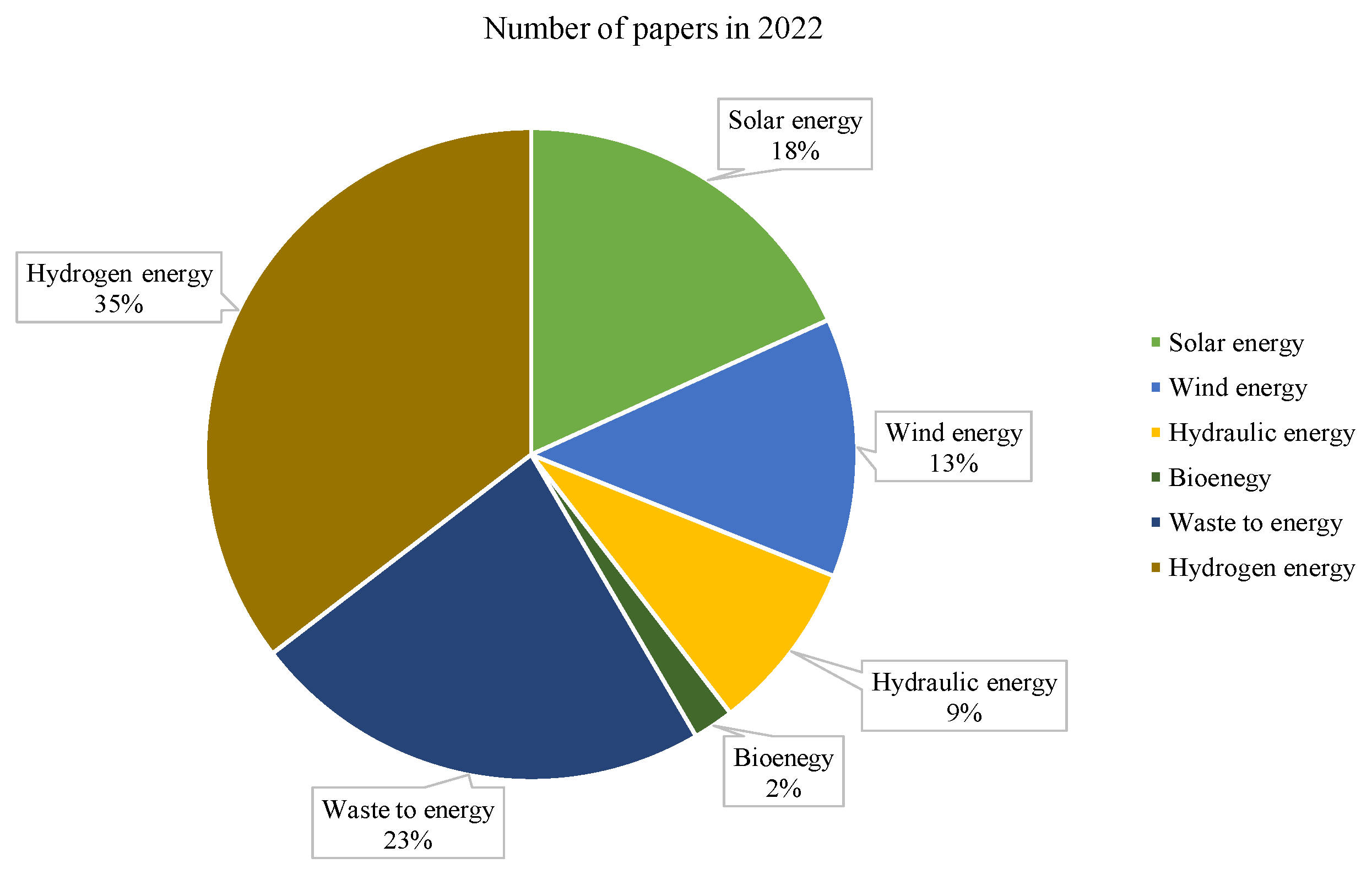
| Articles | Renewable Energy | Contribution | Open Problems | |||||||||
|---|---|---|---|---|---|---|---|---|---|---|---|---|
| Solar | Wind | Bio | Hydraulic | Waste | Hydrogen | Case Study | Review | Model | Management | Methodology | ||
| Köktürk and Tokuç [38][8] | − | Smart grid | − | − | − | − | Turkey | Turkey | − | Yes | − | Yes |
| Watson et al. [39][9] | − | Battery | − | − | − | − | Canada | − | − | − | − | − |
| Ai et al. [40][10] | − | − | − | Storage | − | − | − | Wind turbines | − | Yes | − | Yes |
| Liu et al. [41][11] | − | − | − | Rail vehicles | − | − | − | − | Yes | − | − | − |
| Yu et al. [42][12] | − | − | − | Excavator | − | − | − | − | Yes | Yes | Min-size test | − |
| Yang et al. [43][13] | − | − | − | EHH system | − | − | − | Power system | − | Yes | − | Yes |
| Yang et al. [44][14] | − | − | − | Electric vehicle | − | − | − | − | Yes | Yes | Fuzzy | Yes |
| Wei et al. [45][15] | − | − | − | Wind turbines | − | − | − | − | Yes | − | Simulation | − |
| Abaecherli et al. [46][16] | − | − | − | − | Indust. waste | − | − | − | Mathematical | Yes | MILP | − |
| Zhang et al. [47][17] | − | − | − | − | − | Policy Opt. | China | − | − | Yes | − | − |
| Mohammadi and McGowan [48][18] | − | − | − | − | Brayton cycle | − | − | − | Yes | − | Yes | − |
| Puttachai et al. [49][19] | − | − | − | − | Bi-direc. caus. | − | Germany | − | − | Yes | − | − |
| Lee et al. [50][20] | − | − | − | − | Hybrid system | − | − | Chem. conver. | − | Yes | − | Yes |
| Misganaw and Teffera [51][21] | − | − | − | − | solid | − | Ethiopia | Potential | − | − | − | Yes |
| Apak et al. [52][22] | − | − | − | − | − | Power plant | Yes | Yes | − | Yes | − | Yes |
| Le et al. [53][23] | − | − | − | − | − | Yes | − | − | Yes | − | Yes | − |
| Wei et al. [54][24] | − | − | − | − | − | Yes | − | − | Yes | − | Yes | − |
| Kumar et al. [55][25] | State-of-art | − | − | − | − | − | − | India | − | − | SWOT analysis | Yes |
| Behar et al. [56][26] | Copper mining | − | − | − | − | − | − | Yes | − | − | − | − |
| Xu et al. [57][27] | Solar collector | − | − | − | − | − | − | − | − | − | Simulation | − |
| Lobaccaro et al. [58][28] | Urban planning | − | − | − | − | − | Yes | Yes | − | − | − | Yes |
| Kong et al. [59][29] | − | − | Waste water | − | − | − | − | Recovery | AnMBR | − | − | − |
| Kong et al. [60][30] | − | − | Waste water | − | − | − | − | Recovery | AnMBR | − | − | − |
| Afzal et al. [61][31] | Energy device | − | − | − | − | − | − | Optimization | − | − | Yes | Yes |
| Masera et al. [62][32] | Dairy industry | − | − | − | − | − | Europe | − | − | − | − | − |
| Xiao et al. [63][33] | Food industry | − | − | − | − | − | − | − | Experimental | − | − | − |
| Gao et al. [64][34] | − | Intermittency | − | − | − | − | China | Cost | − | Yes | − | − |
| Bahar et al. [65][35] | − | Analysis | − | − | − | − | − | Tunisia | − | − | − | Yes |
| Govindan [66][36] | − | Barriers | − | − | − | − | − | India | − | − | MCDM | Yes |
| Kong et al. [67][37] | − | − | Waste water | − | − | − | − | Electricity | − | − | − | Yes |
| Jain and Tembhurkar [68][38] | − | − | Fly ash | − | − | − | − | Waste water | − | − | − | Yes |
| Zou et al. [69][39] | − | − | Food waste | − | − | − | − | Enz. pretre. | − | − | − | Yes |
| Li et al. [70][40] | Nanotechnology | − | − | − | − | − | − | Energy storage | − | − | − | Yes |
| Chang et al. [71][41] | − | Anti-icing | − | − | − | − | − | O & M costs | − | − | − | Yes |
2.1. Solar Energy
The use of solar energy is not new in mankind. It starts with a magnifying glass in the 7th century B.C., whereas NASA used the first photovoltaic-based spacecraft in 1964 [72][42]. The development is in the experimental stage anymore; rather, it meets energy demands in daily life. In 2012, solar energy capacity was 100 GW, whereas the growth suppresses 1 TW (1 TW = 1000 GW) in 2022 [73][43]. This growth is almost doubled in the last three years, since 2018, and it is predicted to reach 2.3 TW by 2025 [74][44]. Graph (Figure 62) shows that trends in research on solar energy increase over the year. Until 2020, the moving average curve was flattened and steady. The graph got a hike since 2021 in a different area of application. Abdelrazik et al. [75][45] discussed the potential of adopting solar energy in Africa. They explained that Africa is a great source of photovoltaic power from the sun but faces a lot of challenges for RE due to financial, human, and technological resources. Hao et al. [76][46] analyzed the performance of solar power systems for heating, cooling, and power storage system with a combination of sunbeam splitting. Similarly, a thermochemical reactor used the biomimetic bone porous structure (Shi et al. [77][47]) to improve solar energy conversion. They proved that this method helped to maintain the flow between energy and energy flow within the reactor. That process improved 2.17% solar energy storage efficiency and 8.97% methane conversion.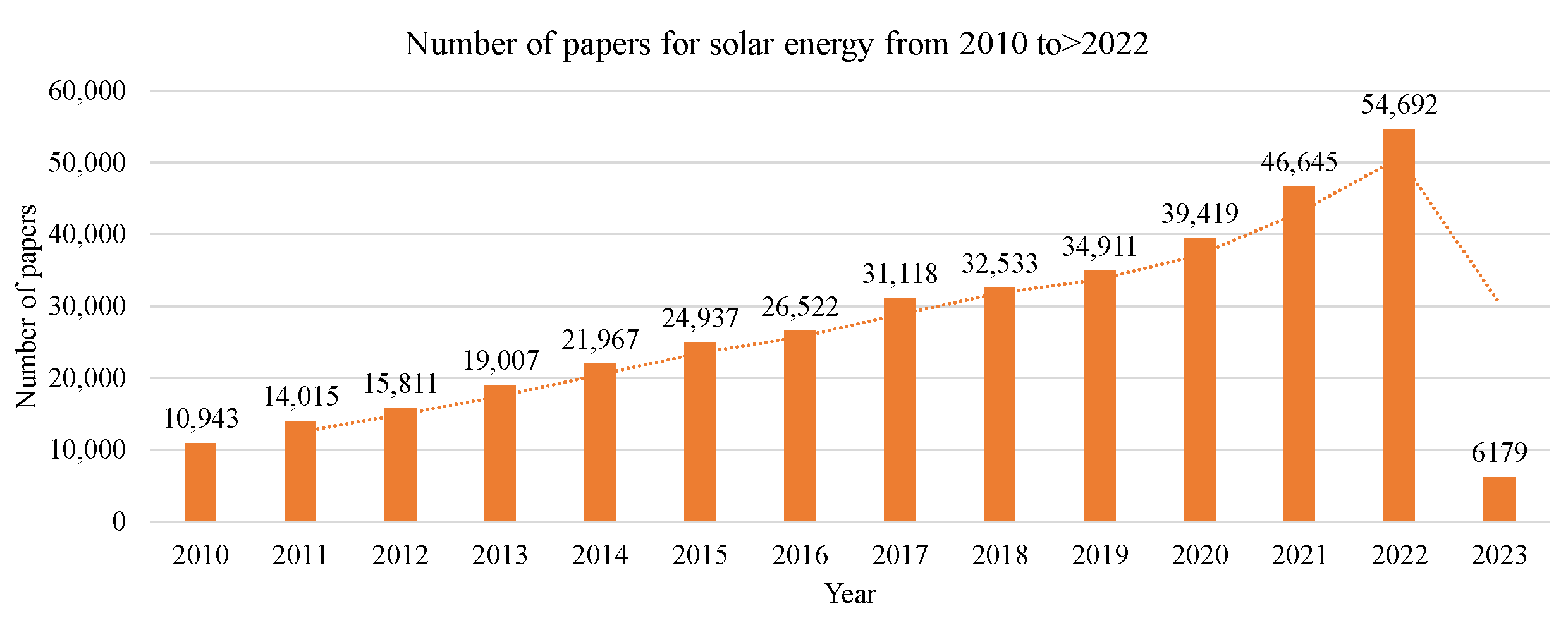
2.2. Wind Energy
The growth of wind energy is gradually increasing every year, and corresponding research articles are growing as well (Figure 73). The history of using wind energy is very old (maybe B.C.), but commercial use started around the 11th century. People began to use windmills for food production in the Middle East. Around the 1800s, Dutch and U.S. people used small wind turbines for farms and cattle ranches [86][56]. Wind power production reached 31,000 MW around the 2000s [87][57]. Two types of wind energy are in progress: one is land-based wind energy, and the other one is offshore wind energy. Land-based wind energy projects are built on land. 99% of wind energy projects are based on private lands [88][58]. In comparison, offshore wind energy projects are built in water (generally seawater). It has fewer conflicts than onshore wind projects due to land issues.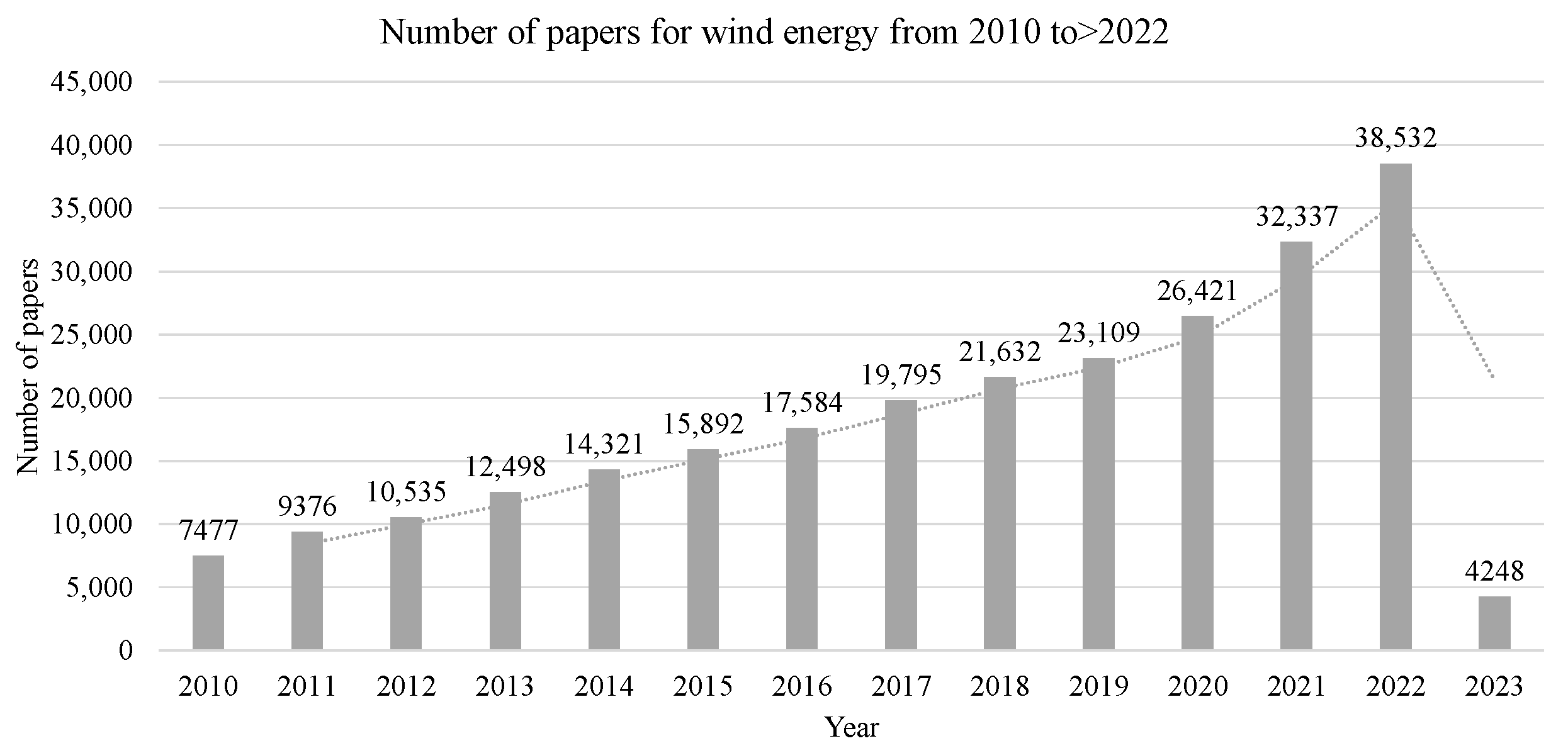
2.3. Bioenergy
Bioenergy is one of the promising renewable energies [96][67], which is produced from biomass (Figure 84). 55% of the total RE comes from bioenergy. Different kinds of bioenergies are biofuel (first, second, third, and fourth generation), biodiesel, and biopower. First-generation biofuel is made from edible biomass. However, it starts to affect the food supply chain worldwide. Then the second-generation biofuel starts to make from nonedible biomass. Still, it affects the wildlife food chain. The third-generation biofuel is made from algae. The third-generation biofuel is more dense, low-cost, and highly energy-efficient. However, it requires a high source of energy to generate lipids. Thus, the fourth-generation biofuel, whose biomass is modified microalgae, comes into the picture. These algae are highly efficient in absorbing CO2CO2 and enhance production fuel [97][68]. Papilo et al. [98][69] gave a review in Indonesia, where palm oil was used for bioenergy. Liu et al. [99][70] discussed a relation between ecological footprint and bioenergy and its effect on the economy. They reviewed the connection using the quantile-on-quantile methodology. Liu et al. [6][71] explained a prediction on the climate change effect on bioenergy, where the biomass was perennial grass. Few studies are found in bioenergy literature, which is used in other sectors as well.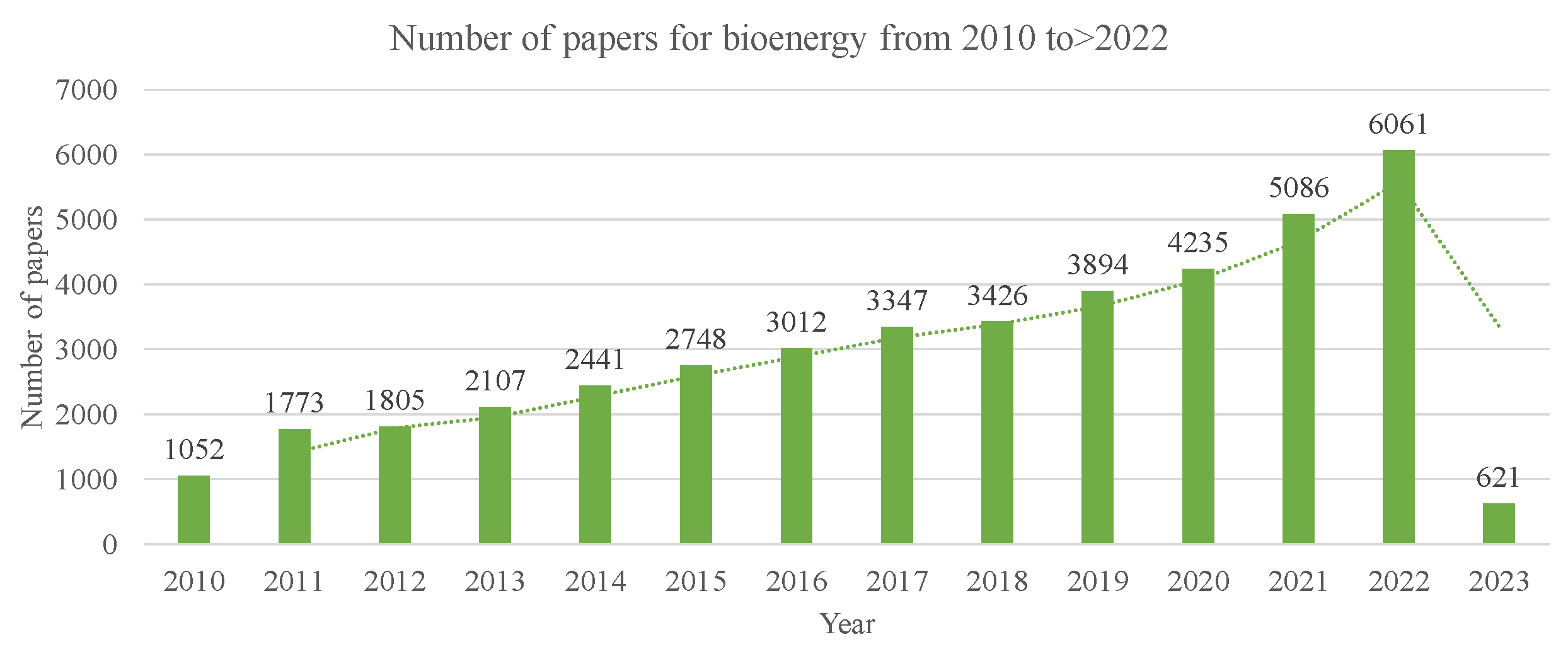
2.4. Hydraulic Energy
Hydraulic energy is a RE where the force of water is used to make the energy. It is mostly used to produce electric energy from the kinetic energy of water. Figure 95 shows the research paper publication for hydraulic energy. The graph is increasing, but it is steady growth. The Spread of RE usage depends on the activity of people as well. Available information about RE in a public forum is important for that. Detailed available information will make society understand the benefit of RE over traditional fuels. This aspect was discussed by Meirinhos et al. [109][81] for the city of Angolan, Central Africa. The city was excessively dependent on oil and caused too much emissions. That study found that hydraulic and biofuel are the two most promising RE. The tidal force is another significant resource of hydraulic energy. Yin et al. [110][82] designed a turbine H∞ that could increase the tidal energy conversion. Their case study analysis using linear matrix inequality (LMI) showed that the energy efficiency of the proposed turbine was up to 40%.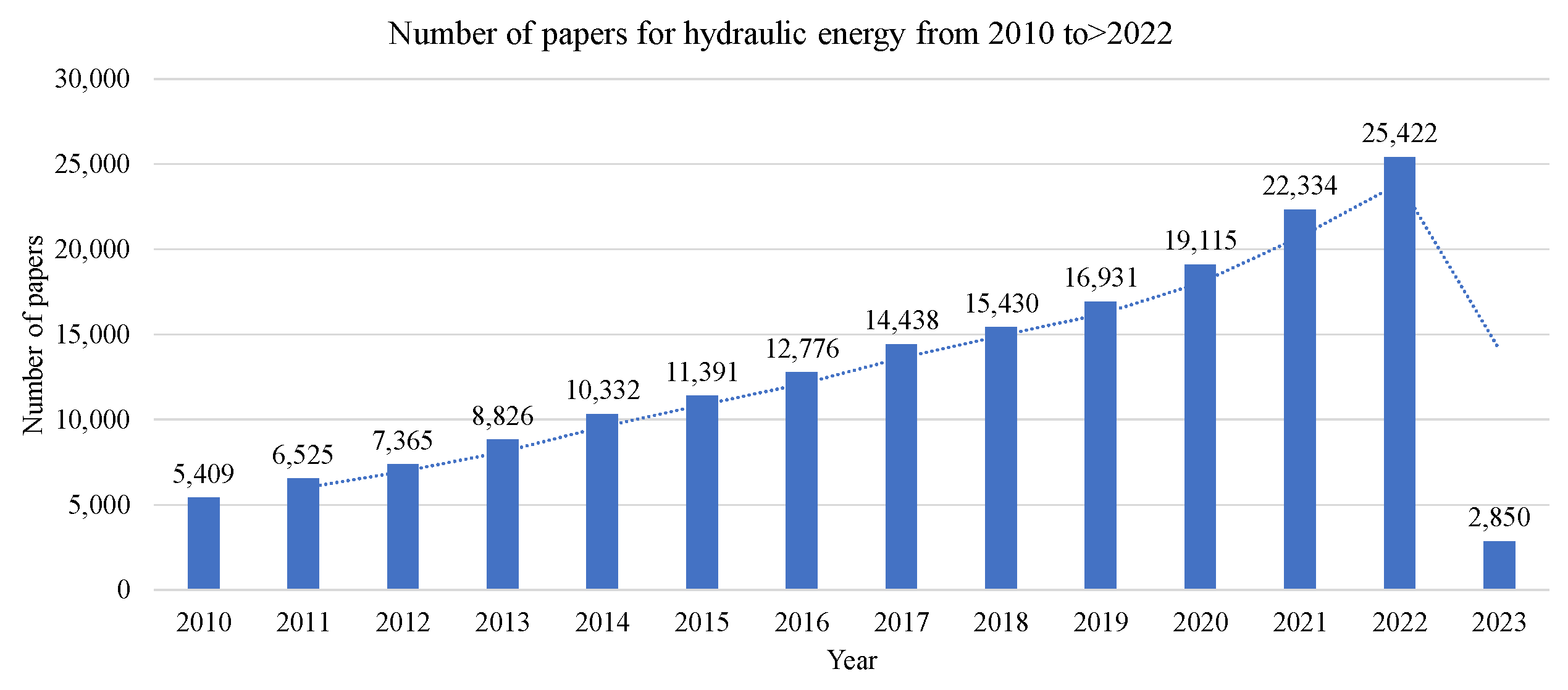
2.5. Waste to Energy and Hydrogen Energy
Waste to energy conversion reduces waste as well as produces energy. Without increasing waste and pollution, waste is used as a promising RE source. There are a lot of different types of waste as food waste, solid waste, municipal waste, and organic waste [116][88]. Conversion equivalency between waste and fossil fuel sources can be represented as: 1 t oil ≃ 4 t wastes and 1 t coal ≃ 2 t wastes [117][89]. Waste to energy conversion has a huge impact on waste management as well as a circular economy. The reason for the impact on circular economy is that the circular economy transfers waste to a new product and waste to energy does the same by converting waste mass balance to energy. Generally, heat or/and electricity are produced from wastes. Figure 106 shows a steady graph for the research in the area of waste to energy.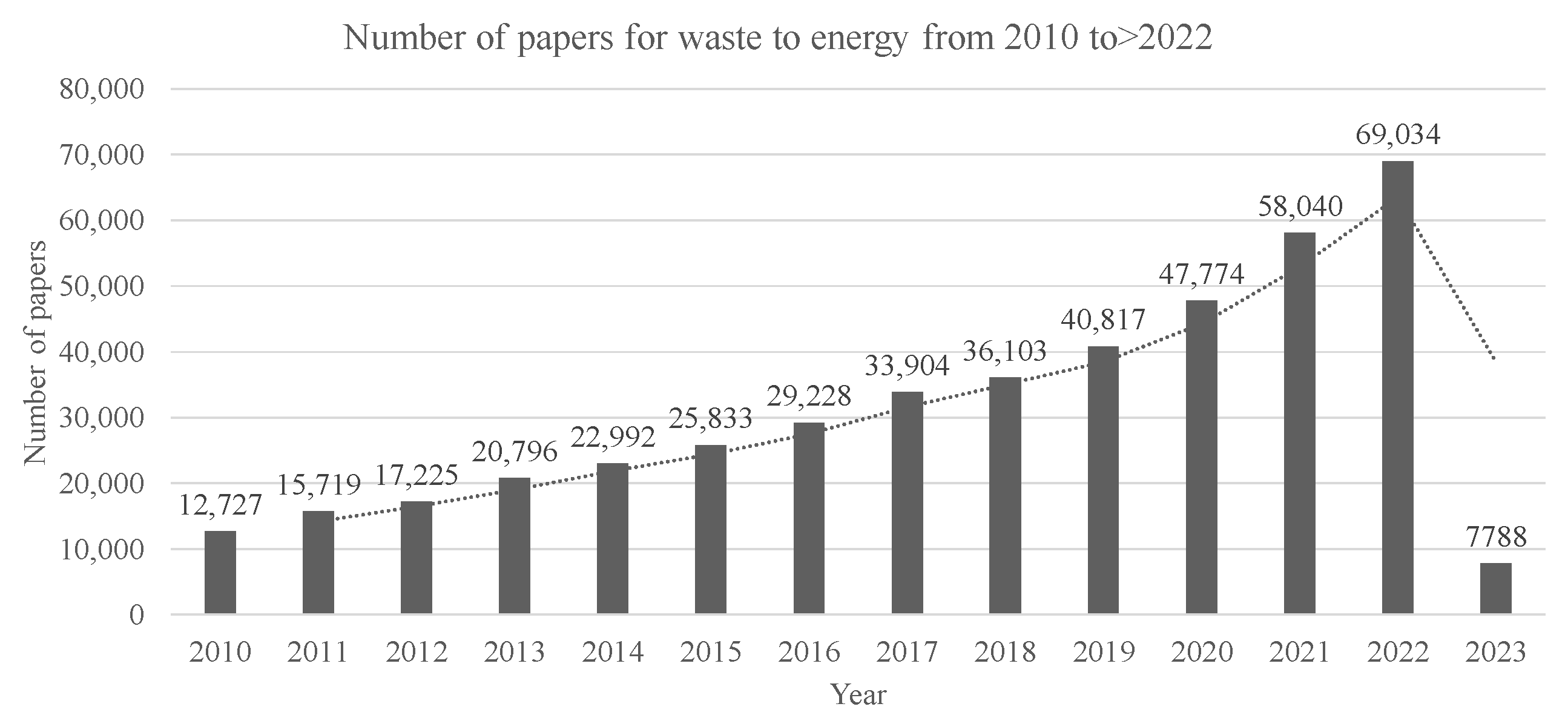
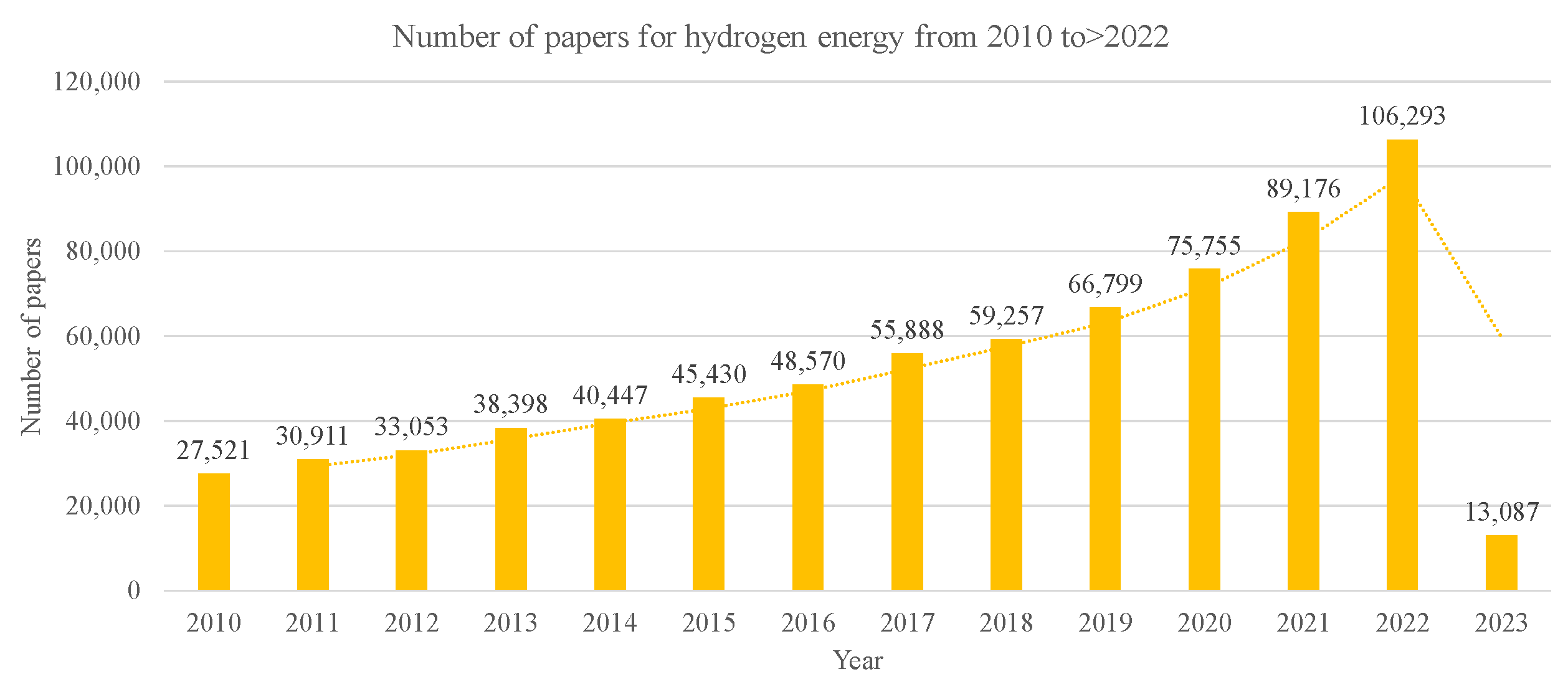
References
- McKinsey & Company. The Decoupling of GDP and Energy Growth: A CEO Guide. Available online: https://www.mckinsey.com/industries/electric-power-and-natural-gas/our-insights/the-decoupling-of-gdp-and-energy-growth-a-ceo-guide (accessed on 12 December 2022).
- Energy Education. Energy Conversion Technology. Available online: https://energyeducation.ca/encyclopedia/Energy_conversion_technology (accessed on 12 December 2022).
- World Economic Forum. Energy Transition. How Can We Store Renewable Energy? 4 Technologies That Can Help. April 2021. Available online: https://www.weforum.org/agenda/2021/04/renewable-energy-storage-pumped-batteries-thermal-mechanical/ (accessed on 12 December 2022).
- ScienceDirect. Available online: https://www.sciencedirect.com/search?qs=renewable%20energy (accessed on 12 December 2022).
- World Economic Forum. Climate Change. ‘Wind and Solar Are Proving Themselves’: Renewables Met Rise in Electricity Demand during First Half of 2022. October 2022. Available online: https://www.weforum.org/agenda/2022/10/wind-and-solar-proving-themselves-renewables-rise-in-electricity-demand-2022/ (accessed on 13 December 2022).
- Financial Times. Solar Power Expected to Surpass Coal in 5 Years, IEA Says. Available online: https://www.ft.com/content/98cec49f-6682-4495-b7be-793bf2589c6d (accessed on 13 December 2022).
- Ember. Data into Actions. Available online: https://ember-climate.org/ (accessed on 13 December 2022).
- Köktürk, G.; Tokuç, A. Vision for Wind Energy with a smart Grid in Izmir. Renew. Sustain. Energy Rev. 2017, 73, 332–345.
- Watson, D.; Rebello, E.; Kii, N.; Fincker, T.; Rodgers, M. Demand and Energy Avoidance by a 2 MWh Energy Storage System in a 10 MW Wind Farm. J. Energy Storage 2018, 20, 371–379.
- Ai, C.; Zhang, L.; Gao, W.; Yang, G.; Wu, D.; Chen, L.; Chen, W.; Plummer, A. A Review of Energy Storage Technologies in Hydraulic Wind Turbines. Energy Convers. Manag. 2022, 264, 115584.
- Liu, H.; Chen, G.; Xie, C.; Li, D.; Wang, J.; Li, S. Research on Energy-saving Characteristics of Battery-Powered Electric-hydrostatic Hydraulic Hybrid Rail Vehicles. Energy 2020, 205, 118079.
- Yu, Y.; Do, T.C.; Park, Y.; Ahn, K.K. Energy Saving of Hybrid Hydraulic Excavator with Innovative Powertrain. Energy Convers. Manag. 2021, 244, 114447.
- Yang, J.; Liu, B.; Zhang, T.; Hong, J.; Zhang, H. Application of Energy Conversion and Integration Technologies Based on Electro-hydraulic Hybrid Power Systems: A Review. Energy Convers. Manag. 2022, 272, 116372.
- Yang, J.; Liu, B.; Zhang, T.; Hong, J.; Zhang, H. Multi-parameter Controlled Mechatronics-electro-hydraulic Power Coupling Electric Vehicle Based on Active Energy Regulation. Energy 2023, 263, 125877.
- Wei, G.; Jiani, G.; Lin, Z.; Pengfei, Z.; Die, W.; Lijuan, C.; Chao, A. Bivariate Active Power Control of Energy Storage Hydraulic Wind Turbine. J. Energy Storage 2022, 55, 105433.
- Abaecherli, M.L.; García, E.C.; Szijjarto, A.; Hungerbühler, K. Optimized Energy Use Through Systematic Short-term Management of Industrial Waste Incineration. Comput. Chem. Eng. 2017, 104, 241–258.
- Zhang, Q.; Chen, W.; Ling, W. Policy Optimization of Hydrogen Energy Industry Considering Government Policy Preference in China. Sustain. Prod. Consum. 2022, 33, 890–902.
- Mohammadi, K.; McGowan, J.G. Thermoeconomic Analysis of Multi-stage Recuperative Brayton Cycles: Part II – Waste Energy Recovery Using CO2 and Organic Rankine Power Cycles. Energy Convers. Manag. 2019, 185, 920–934.
- Puttachai, W.; Tarkhamtham, P.; Yamaka, W.; Maneejuk, P. Linear and Nonlinear Causal Relationships Between Waste-to-energy and Energy Consumption in Germany. Energy Rep. 2021, 7, 286–292.
- Lee, J.; Lin, K.Y.A.; Jung, S.; Kwon, E.E. Hybrid Renewable Energy Systems Involving Thermochemical Conversion Process for Waste-to-energy Strategy. Chem. Eng. J. 2023, 452, 139218.
- Misganaw, A.; Teffera, B. An Assessment of the Waste-to-energy Potential of Municipal Solid Wastes in Ethiopia. Bioresour. Technol. Rep. 2022, 19, 101180.
- Apak, S.; Atay, E.; Tuncer, G. Renewable Hydrogen Energy and Energy Efficiency in Turkey in the 21st Century. Int. J. Hydrogen Energy 2017, 42, 2446–2452.
- Le, S.T.; Nguyen, T.N.; Linforth, S.; Ngo, T.D. Safety Investigation of Hydrogen Energy Storage Systems Using Quantitative Risk Assessment. Int. J. Hydrogen Energy 2023, 48, 2861–2875.
- Wei, D.; Wei, P.; Li, D.; Ying, Z.; Hao, X.; Xue, Z. Intelligent Damping Control of Renewable Energy/hydrogen Energy DC Interconnection System. Energy Rep. 2022, 8, 972–982.
- Kumar, M.S.C.; Singh, S.; Gupta, M.K.; Nimdeo, Y.M.; Raushan, R.; Deorankar, A.V.; Kumar, T.M.A.; Chanotiya, C.S.; Pakhale, V.D.; Nannaware, A.D. Solar Energy: A Promising Renewable Source for Meeting Energy Demand in Indian Agriculture Applications. Sustain. Energy Technol. Assess. 2023, 55, 102905.
- Behar, O.; Pena, R.; Kouro, S.; Kracht, W.; Fuentealba, E.; Moran, L.; Sbarbaro, D. The Use of Solar Energy in the Copper Mining Processes: A Comprehensive Review. Chem. Eng. Technol. 2021, 4, 100259.
- Xu, B.; Xu, J.; Chen, Z. Heat Transfer Study in Solar Collector with Energy Storage. Int. J. Heat Mass Transf. 2020, 156, 119778.
- Lobaccaro, G.; Croce, S.; Lindkvist, C.; Probst, M.C.M.; Scognamiglio, A.; Dahlberg, J.; Lundgren, M.; Wallg, M. A Cross-country Perspective on Solar Energy in Urban Planning: Lessons Learned from International Case Studies. Renew. Sustain. Energy Rev. 2019, 108, 209–237.
- Kong, Z.; Li, L.; Wu, J.; Wang, T.; Rong, C.; Luo, Z.; Pan, Y.; Li, D.; Li, Y.; Huang, Y.; et al. Evaluation of Bio-energy Recovery from the Anaerobic Treatment of Municipal Wastewater by a Pilot-scale Submerged Anaerobic Membrane Bioreactor (AnMBR) at Ambient Temperature. Bioresour. Technol. 2021, 339, 125551.
- Kong, Z.; Xue, Y.; Hao, T.; Zhang, Y.; Wu, J.; Chen, H.; Song, L.; Rong, C.; Li, D.; Pan, Y.; et al. Carbon-neutral Treatment of N, N-dimethylformamide-containing Industrial Wastewater by Anaerobic Membrane Bioreactor (AnMBR): Bio-energy Recovery and CO2 Emission Reduction. Bioresour. Technol. 2022, 358, 127396.
- Afzal, A.; Buradi, A.; Jilte, R.; Shaik, S.; Kaladgi, A.R.; Arıcı, M.; Lee, C.T.; Nizetic, S. Optimizing the Thermal Performance of Solar Energy Devices Using Meta-heuristic Algorithms: A Critical Review. Renew. Sustain. Energy Rev. 2023, 173, 112903.
- Masera, K.; Tannous, H.; Stojceska, V.; Tassou, S. An Investigation of the Recent Advances of the Integration of Solar Thermal Energy Systems to the Dairy Processes. Renew. Sustain. Energy Rev. 2023, 172, 113028.
- Xiao, X.; Wang, M.; Cao, G. Solar Energy Harvesting and Wireless Charging based Temperature Monitoring System for Food Storage. Sens. Int. 2023, 4, 100208.
- Gao, Y.; Ma, S.; Wang, T.; Wang, T.; Gong, Y.; Peng, F.; Tsunekawa, A. Assessing the Wind Energy Potential of China in Considering its Variability/Intermittency. Energy Convers. Manag. 2020, 226, 113580.
- Bahar, F.A.; Ritschel, U.; Akari, P.; Abdeljelil, I.; Amairi, M. Wind Energy Deployment in Tunisia: Status, Drivers, Barriers and Research Gaps—A Comprehensive Review. Energy Rep. 2021, 7, 7374–7389.
- Govindan, K. Pathways to Low Carbon Energy Transition Through Multi Criteria Assessment of Offshore Wind Energy Barriers. Technol. Forecast. Soc. Change 2023, 187, 122131.
- Kong, Z.; Hao, T.; Chen, H.; Xue, Y.; Li, D.; Pan, Y.; Li, Y.; Li, Y.Y.; Huang, Y. Anaerobic Membrane Bioreactor for Carbon-neutral Treatment of Industrial Wastewater Containing N, N-dimethylformamide: Evaluation of Electricity, Bio-energy Production and Carbon Emission. Environ. Res. 2023, 216, 114615.
- Jain, S.; Tembhurkar, A.R. Sustainable Amelioration of Fly Ash Dumps Linking Bio-energy Plantation, Bioremediation and Amendments: A Review. J. Environ. Manag. 2022, 314, 115124.
- Zou, L.; Wan, Y.; Zhang, S.; Luo, J.; Li, Y.Y.; Liu, J. Valorization of Food Waste to Multiple Bio-energies Based on Enzymatic Pretreatment: A Critical Review and Blueprint for the Future. J. Clean. Prod. 2020, 277, 124091.
- Li, Q.; Liu, Y.; Guo, S.; Haoshen Zhou, H. Solar Energy Storage in the Rechargeable Batteries. Nano Today 2017, 16, 46–60.
- Chang, C.C.W.; Ding, T.J.; Ping, T.J.; Ariannejad, M.; Chao, K.C.; Samdin, S.B. Fault Detection and Anti-icing Technologies in Wind Energy Conversion Systems: A Review. Energy Rep. 2022, 8, 28–33.
- U.S. Department of Energy. Energy Efficiency & Renewable Energy. Available online: https://www1.eere.energy.gov/solar/pdfs/solar_timeline.pdf (accessed on 13 December 2022).
- SolarPower Energy. 2022: The Year of Terawatt Solar Global Installed Solar Capacity Expected to Hit Terawatt Mark in Early 2022. January 2022. Available online: https://www.solarpowereurope.org/news/2022-the-year-of-terawatt-solar (accessed on 13 December 2022).
- SolarPower Energy. Global Market Outlook For Solar Power 2022-2026. Available online: https://www.solarpowereurope.org/insights/market-outlooks/global-market-outlook-for-solar-power-2022 (accessed on 13 December 2022).
- Abdelrazik, M.K.; Abdelaziz, S.E.; Hassan, M.F.; Hatem, T.M. Climate action: Prospects of Solar Energy in Africa. Energy Rep. 2022, 8, 11363–11377.
- Hao, X.; Shan, S.; Gao, N.; Chen, G.; Wang, Q.; Gu, T. Performance Analysis of a Novel Combined Cooling, Heating and Power System with Solar Energy Spectral Beam Splitting. Energy Conver. Manag. 2023, 276, 116500.
- Shi, X.; Wang, F.; Lougou, B.G.; Zhang, H.; Wei, X.; Li, D.; Xu, J. Experimental and Numerical Study Regarding the Biomimetic Bone Porous Structure to Match Energy and Mass Flow in a Solar Thermochemical Reactor. J. Energy Storage 2022, 55, 105645.
- Mannepalli, K.; Vinoth, K.; Mohapatra, S.K.; Rahul, R.; Gangodkar, D.P.; Madduri, A.; Ravichandran, M.; Sathyamurthy, R.; Mohanavel, V. Allocation of Optimal Energy From Storage Systems Using Solar Energy. Energy Rep. 2022, 8, 836–846.
- Lei, L.; Liu, X.; Wang, H.; Zou, Y.; Xu, Y.; Xu, M. Performance Analysis of a Novel Mode using Solar Energy to Recycle and Reuse Water Vapor from Flue Gas of Coal-Fired Power Station. Energy Conver. Manag. 2023, 276, 116537s.
- Balachandran, S.; Swaminathan, J. Advances in Indoor Cooking Using Solar Energy with Phase Change Material Storage Systems. J. Energies 2022, 15, 8775.
- Abdullah-Al-Mahbub, M.; Islam, A.R.M.T.; Almohamad, H.; Dughairi, A.A.A.; Al-Mutiry, M.; Abdo, H.G. Different Forms of Solar Energy Progress: The Fast-Growing Eco-Friendly Energy Source in Bangladesh for a Sustainable Future. J. Energies 2022, 15, 6790.
- Wikipedia. Solar Power in China. Available online: https://en.wikipedia.org/wiki/Solar_power_in_China (accessed on 14 December 2022).
- Wikipedia. Renewable Energy. Available online: https://en.wikipedia.org/wiki/Renewable_energy (accessed on 7 December 2022).
- Solar Feeds. Top 10 Country Uses the Most Solar Energy. February 2022. Available online: https://www.solarfeeds.com/mag/top-10-country-uses-the-most-solar-energy/ (accessed on 14 December 2022).
- World Economic Forum. Energy Transition. 5 Unexpected Places in the World for Solar Power Generation. May 2022. Available online: https://www.weforum.org/agenda/2022/05/solar-power-energy-unusual-sites/ (accessed on 14 December 2022).
- U.S. Energy Information Administration (EIA). Wind Explained History of Wind Power. March 2022. Available online: https://www.eia.gov/energyexplained/wind/history-of-wind-power.php#:∼:text=American%20colonists%20used%20windmills%20to,turbines)%20were%20also%20widely%20used (accessed on 14 December 2022).
- Renewable Energy World. History of Wind Turbines. November 2014. Available online: https://www.renewableenergyworld.com/storage/history-of-wind-turbines/#gref (accessed on 14 December 2022).
- American Clean Power. Land-Based Wind Siting. Available online: https://cleanpower.org/policy/land-based-wind-siting/ (accessed on 15 December 2022).
- Frantál, B.; Frolova, M.; Liñán-Chacón, J. Conceptualizing the Patterns of Land use Conflicts in Wind Energy Development: Towards a Typology and Implications for Practice. J. Energy Res. Soc. Sci. 2023, 95, 102907.
- Hu, W.; E, J.; Leng, J.; Zhang, F.; Chen, J.; Ma, Y. Investigation on Harvesting Characteristics of Convective Wind Energy From Vehicle Driving on Multi-Lane Highway. J. Energy 2023, 263, 126062.
- Lee, M.K.; Nam, J.; Kim, M. Valuing the Public Preference for Offshore Wind Energy: The Case Study in South Korea. J. Energy 2023, 263, 125827.
- Younis, A.; Dong, Z.; Badway, M.E.; Khatib, F.A.; Anazi, A.A. Development of Low-Speed Wind Energy Harvesting Device. J. Energy Rep. 2022, 8, 22–27.
- Zhu, J.; Hu, W.; Xu, X.; Liu, H.; Pan, L.; Fan, H.; Zhang, Z.; Chen, Z. Optimal Scheduling of a Wind Energy Dominated Distribution Network via a Deep Reinforcement Learning Approach. J. Renew. Energy 2022, 201, 792–801.
- Mordor Intelligence. Sweden Wind Energy Market - Growth, Trends, COVID-19 Impact, and Forecasts (20223 - 2028). Available online: https://www.mordorintelligence.com/industry-reports/sweden-wind-energy-market (accessed on 13 December 2022).
- Sweden Sverige. Swedes Use a Lot of Energy – Yet, Emissions are Low. The key? Renewable Energy. Available online: https://sweden.se/climate/sustainability/energy-use-in-sweden (accessed on 13 December 2022).
- Travel Tomorrow. What Are the Countries Leading the Wind Energy Transition? October 2022. Available online: https://traveltomorrow.com/what-are-the-countries-leading-the-wind-energy-transition/ (accessed on 15 December 2022).
- Banerjee, S.; Singh, R.; Singh, V. Bioenergy Crops as Alternative Feedstocks for Recovery of Anthocyanins: A Review. Environ. Tech. Innov. 2023, 29, 102977.
- Aron, N.S.M.; Khoo, K.S.; Chew, K.W.; Show, P.L.; Chen, W.H.; Nguyen, T.H.P. Sustainability of the Four Generations of Biofuels – A Review. Int. J. Energy Res. 2020, 44, 9266–9282.
- Papilo, P.; Marimin, M.; Hambali, E.; Machfud, M.; Yani, M.; Asrol, M.; Evanila, E.; Prasetya, H.; Mahmud, J. Palm Oil-Based Bioenergy Sustainability and Policy in Indonesia and Malaysia: A Systematic Review and Future Agendas. Heliyon 2022, 8, e10919.
- Liu, X.; Liu, M.; Huang, Y.; Meo, M.S. Analysis of Asymmetries in the Nexus Between Bioenergy and Ecological Footprint: Evidence from European Eeconomies. Biomass Bioenergy 2023, 167, 106605.
- Liu, W.; Wang, K.; Hao, H.; Yan, Y.; Zhang, H.; Zhang, H.; Peng, C. Predicting Potential Climate Change Impacts of Bioenergy from Perennial Grasses in 2050. Resour. Conserv. Recycl. 2023, 190, 106818.
- Wang, G.; Liao, Q.; Zhang, H.; Liang, Y. How Government Policies Promote Bioenergy’s Permeability in National-Level Energy Supply Chain: A Case of China. Appl. Energy 2022, 324, 119750.
- Vu, D.K.N.; Thi, Y.N.N.; Tran, L.Q. Potential Biofuel Exploitation from Two Common Vietnamese Euphorbia Plants (Euphorbiaceae). Biofuels Bioprod. Biorefin. 2023.
- Sathre, R.; Gustavsson, L. Lifecycle Climate Impact and Primary Energy Use of Electric and Biofuel Cargo Trucks. GCB Bioenergy 2023, 1–24.
- Bhuniya, S.; S Pareek, S.; Sarkar, B. A Sustainable Game Strategic Supply Chain Model with Multi-factor Dependent Demand and Mark-up Under Revenue Sharing Contract. Comp. Intell. Syst. 2023.
- Singh, S.K.; Chauhan, A.; Sarkar, B. Supply Chain Management of E-Waste for End-of-Life Electronic Products with Reverse Logistics. Mathematics 2023, 11, 124.
- Mridha, B.; Ramana, G.V.; Pareek, S.; Sarkar, B. An Efficient Sustainable Smart Approach to Biofuel Production with Emphasizing the Environmental and Energy Aspects. Fuel 2023, 336, 126896.
- Mridha, B.; Goswami, A.; Pareek, S.; Sarkar, B. Joint Effects of Production Quality Improvement of Biofuel and Carbon Emissions Towards a Smart Sustainable Supply Chain Management. J. Clean. Prod. 2023, 386, 135629.
- Singh, S.K.; Chauhan, A.; Sarkar, B. Sustainable Biodiesel Supply Chain Model Based on Waste Animal Fat with Subsidy and Advertisement. J. Clean. Prod. 2023, 382, 134806.
- IEA. Bioenergy. Available online: https://www.iea.org/reports/bioenergy (accessed on 15 December 2022).
- Meirinhos, G.; Malebo, M.; Cardoso, A.; Silva, R.; Rêgo, R. Information and Public Knowledge of the Potential of Alternative Energies. Energies 2022, 15, 4928.
- Yin, X.; Pan, L.; Lei, M. Maximizing Tidal Energy Conversion by Adopting Hydraulic Transformation and LMI Based Robust Control. Renew. Energy 2022, 195, 331–343.
- Hočevar, M.; Novak, L.; Drešar, P.; Rak, G. The Status Quo and Future of Hydropower in Slovenia. Energies 2022, 15, 6977.
- Caricimi, R.; Dranka, G.G.; Setti, D.; Ferreira, P. Reframing the Selection of Hydraulic Turbines Integrating Analytical Hierarchy Process (AHP) and Fuzzy VIKOR Multi-Criteria Methods. Energies 2022, 15, 7383.
- Bütüner, M.A.; Koşalay, İ.; Gezer, D. Machine-Learning-Based Modeling of a Hydraulic Speed Governor for Anomaly Detection in Hydropower Plants. Energies 2022, 15, 7974.
- Chi, F.; Pan, J.; Liu, Y.; Guo, Y. Improvement of Thermal Comfort by Hydraulic-Driven Ventilation Device and Space Partition Arrangement Towards Building Energy Saving. Appl. Energy 2021, 299, 117292.
- Iyer, K.R.; Roozbahani, H.; Alizadeh, M.; Handroos, H. A Novel Approach for Direct Conversion of Wind Energy to Heat Utilizing a Hydraulic Medium for Domestic Heating Applications. Energy Rep. 2022, 8, 11139–11150.
- Office of Energy Efficiency and Renewable Energy. Waste-to-Energy. Available online: https://www.energy.gov/eere/bioenergy/waste-energy (accessed on 22 December 2022).
- Bancook & Wilcox. Waste to Energy Overview: Ecologically Sound, Cost-Effective Energy. Available online: https://www.babcock.com/home/renewable/waste-to-energy/waste-to-energy-technology (accessed on 22 December 2022).
- Caferra, R.; D’Adamo, I.; Morone, P. Wasting Energy or Energizing Waste? The Public Acceptance of Waste-to-Energy Technology. Energy 2023, 263, 126123.
- Yadav, D.; Singh, R.; Kumar, A.; Sarkar, B. Reduction of Pollution Through Sustainable and Flexible Production by Controlling By-Products. J. Environ. Inform. 2022, 40, 106–124.
- Yatim, F.E.; Boumanchar, I.; Srhir, B.; Chhiti, Y.; Jama, C.; Alaoui, F.E.M. Waste-to-Energy as a Tool of Circular Economy: Prediction of Higher Heating Value of Biomass by Artificial Neural Network (ANN) and Multivariate Linear Regression (MLR). Waste Manag. 2022, 153, 293–303.
- Silva, M.G.; Przybysz, A.L.; Piekarski, C.M. Location as a Key Factor for Waste to Energy Plants. J. Clean. Prod. 2022, 379, 134386.
- Blue Ocean. Turning Waste to Energy: Sweden’s Recycling Revolution. Available online: https://www.blueoceanstrategy.com/blog/turning-waste-energy-sweden-recycling-revolution/#:\$\sim$:text=Only%201%25%20of%20Sweden’s%20trash,homes%20and%20electricity%20to%20250%2C000 (accessed on 2 February 2023).
